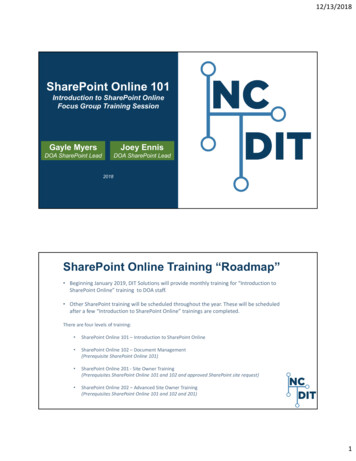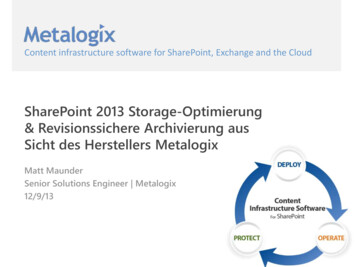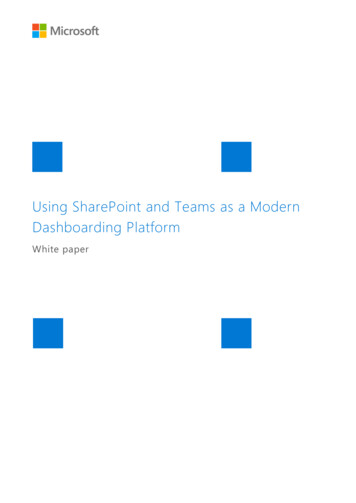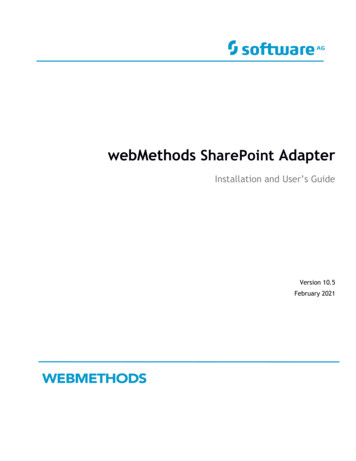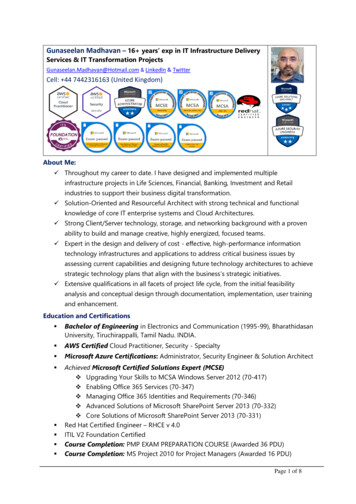
Transcription
Delivering Business Value Through SharePointwww.infotech.comImpact Research1
Table of ContentsExecutive Summary . .Research Method . .What is SharePoint? .What Are the Different Versions? .Who is Using SharePoint?. .Why are Companies Implementing? . .What are the Challenges? How is an Implementation Completed?. .Key Conclusions. . . Case Studies .www.infotech.comImpact Research369162123303655592
Executive Summarywww.infotech.comImpact Research3
Executive SummarySharePoint brings business value to many companies SharePoint users report that the tool delivers majorbusiness value with a low total cost of ownership.SharePoint’s rapid adoption is an indicator of itsvalue.Companies are attracted by these six functions ofSharePoint: Collaboration Portal Enterprise Search Content Management Business Forms Business IntelligenceSharePoint and Similar Tools 501-10001001-50005000 EmployeesImplementedCurrently Planning/ImplementingThis report will help you with your SharePoint deployment by:1. Explaining each of the six functions and how they are used.2. Identifying realizable benefits.3. Warning of challenges that you might face and how to mitigate them.4. Providing a comprehensive guide for completing a successful implementation.www.infotech.comImpact Research4
Executive SummarySharePoint brings a wide range of benefits Companies have reported thatSharePoint benefits impact thecompany, the end users, and IT.Companies of all sizes andindustries have implementedSharePoint and reaped benefits.SharePoint’s impact on anorganization is most oftendefined as positive businessvalue rather than pure costsavings.SharePoint is more than just a platform. It transforms the way IT and end users conduct their dailywork by enabling more efficient communication and collaboration.www.infotech.comImpact Research5
Research Methodwww.infotech.comImpact Research6
Research MethodResearch MethodSharePoint is a key consideration for many companiesSharePoint was selected as the focus of this in-depth report because: Adoption statistics indicate that 34% of companies will deploy SharePoint or an equivalent tool by end-of-year 2007, anadditional 25% will deploy by the end of 2008, and 19% plan to deploy between 2009-2011. Our survey of 2,000 companies found that 61% of enterprises focus on .NET, while only 23% are primarily Java.SharePoint is built on the .NET framework, and is a logical choice for .NET shops. There is high demand from Info-Tech clients for research on SharePoint.Info-Tech’s research process for SharePoint This research is based on real world client experiences. Companies were interviewed and surveyed to analyzeadoption drivers, implementation considerations, benefits realized and challenges faced.Info-Tech Research Group content is driven by the needs of our 21,000 enterprise customers and is in no waysponsored, paid for, or initiated by any external vendor or service provider.If SharePoint isn’t for youIf you already know that SharePoint doesn’t fit well with your company, please see the following ITA Premium research notes: Portals: “Portal Marketscape: SharePoint Not the Only Option in 2007” and “Portals: Think Platforms, Not Products” Enterprise Search: “Demystify Enterprise Search to Unveil Business Process Success” and “Break Content ManagementSilos with After-Market Search” Content Management: “Web Content Management Solutions” Business Forms: “Vendor Landscape: Affordable E-Forms for Small Enterprises” Business Intelligence: “BI Competency Center: Prevent Pricey Mistakes”www.infotech.comImpact Research7
Research MethodDistribution by Company SizeProfile of Clients Interviewed1 - 100(12%)5000 (19%)101 - 250(12%)Our in-depth research approach delved into theimplementations of 258 organizations across arepresentative sample of industries and sizes. Of these,217 filled out a comprehensive survey and 41 engaged inan extensive interview.251 - 500(16%)1001 - 5000(23%)Distribution by Industry501 - 1000(18%)Primary, 2%Distribution by Total SpendRetail/Wholesale, 4%Trans/Utilities/Comm, 5%Education, 8%Business Services, 28%more than 70K(19%)less than 3K(19%)Government, 11% 26K - 70K(21%) 3K - 10K(24%)Healthcare, 11%Manufacturing, 19%Financial Services, 12%www.infotech.com 11K - 25K(17%)Impact Research8
What is SharePoint?www.infotech.comImpact Research9
Defining SharePointSharePoint addresses many business needsSharePoint is A platform for collaboration. The ability to design, deploy, andmanage enterprise portals. A way of searching for people andinformation. A forum for enterprise contentmanagement. The capability to streamline formsdriven business processes. Business Intelligence (BI) for everyemployee to make better hSharePoint can help an enterprise manage content and processes, improve business insight,enhance collaboration, and empower IT to make a strategic impact.www.infotech.comImpact Research10
Defining SharePointSharePoint can be broken down into 6 functional areasSource: MicrosoftFunctionComponentsDocs/tasks/calendars, blogs, wikis, e-mailCollaboration integration, project management “lite”,Outlook integration, offline int products provide collaboration functions that helpkeep employees connected. This improves communicationbetween teams while giving easy access to the people andinformation employees need to succeed in their jobs.Enterprise Portal template, Site Directory,My Sites, social networking, privacycontrolThe portal functions enable enterprises to use a singleplatform for Internet, Intranet, and Extranet content andapplications.Enterprise scalability, contextualreference, rich data and people searchSharePoint Enterprise search provides users with the abilityto find relevant people, documents, and business data.Integrated document management,Contentrecords management, web contentManagement management with policies and workflowSharePoint provides core document managementfunctionality such as versioning, check-in/check-out,document locking, metadata, workflow, and access controls.BusinessFormsRich and Web forms based front-ends,line of business actions, enterprise singlesign-onCompanies can streamline forms-driven business processeswith electronic forms that integrate with existing systems.BusinessIntelligence(BI)Server-based Excel spreadsheets anddata visualization, Report Center, BI WebParts, KPIs/DashboardsSharePoint provides BI capabilities so employees can share,control, and reuse business information to improve businessdecision making.www.infotech.comImpact Research11
Defining SharePointCollaboration is the biggest driving force There are two drivers motivating companies to choose SharePoint:Functional DriversEnvironment Drivers58%55%45%Microsoft ShopCollaboration FunctionalityOrganizations already standardizedon the .Net development platformare likely to choose SharePoint overJava-based solutions.The most-cited driving force, collaborationfeatures, are crucial to enablingorganizations to drive business value fromemployees.67%Ease of Implementation/UseContent Management FunctionalityUse of other Microsoft applicationsmakes deployment and end useradoption easier.50% Document management has now extendedLow CostThe low total cost of ownership ofSharePoint drives adoption.to include records management, Webcontent management, and workflow.46%Portal FunctionalityUsers are beginning to demand featuresthat a portal brings.Companies report that they chose SharePoint because it is a cost-effective means to empower endusers to collaborate, share information and feel a sense of ownership in the company.www.infotech.comImpact Research12
Use by FunctionCollaboration most popular SharePoint application Collaboration is the most widely used functionality, in part due to its inclusion with everyversion of SharePoint. Business Forms and Business Intelligence are more specialized functions used only byorganizations with needs in those areas.SharePoint Functionality 9%14%Currently usingEnterprise ContentManagement30%12%18%25%16%Currently implementingPlanning stage25%Enterprise Search10%14%27%24%Considering/ evaluatingNo PlansBusiness Forms22%Business 30%29%24%26%40%50%40%60%Impact Research70%80%90%100%13
Case Study ExamplesThere are many unique ways to use SharePointFunctionalityMini Case StudyCollaborationA large distribution business uses the collaboration features of SharePoint to deal with customerorder change requests. Sales, shipping, production, and transportation all subscribe to this list andreceive alerts when a change is requested. If a customer wants to receive a hundred more casesof product, all of the groups convene via SharePoint to decide whether or not this is possible, andin what timeframe.PortalA mid-sized healthcare organization implemented SharePoint for the Portal capabilities. Thecompany is able to deliver important messages to a wide audience in a cost-effective manner.Information is updated regularly by the end users, which ensures dynamic content whileminimizing IT maintenance costs. Internal communication has improved as a result sinceemployees have a central repository to find information, announcements, and business metrics.EnterpriseSearchA large architectural and engineering firm chose the Enterprise Search from SharePoint over athird party tool. Not only did they save on licensing costs, but now employees are able to find theright information and people needed to do their jobs well.www.infotech.comImpact Research14
Case Study ExamplesThere are many unique ways to use SharePoint - contFunctionalityMini Case StudyEnterpriseContentManagementA large manufacturing company is using SharePoint for their document management and recordsmanagement. One of the big issues that the company had to tackle was their e-discovery. Theywanted to have control over all of their business content and records that should be shared at thedepartmental or organizational level. SharePoint is the repository for content and houses it insteadof PST files on hard drives.BusinessFormsA mid-sized financial services company took paper-based HR forms and used InfoPath 2007 (aSharePoint technology) to streamline this workflow. In the past, employees had to contact HR forthe required document, fill it out manually, and submit it back to HR for them to manually enter inthe data. Now, users have a central place to find forms and submit everything electronically. Data isautomatically entered into the database. As a result, 1.5 FTE HR employees were saved,employees save time, and data is more accurate.BusinessIntelligenceA school district uses Excel Services (a SharePoint technology) to create dashboards forexecutives around student data. For example, this enables them to easily track enrollments, classsizes and composition, special needs students, etc., in order to remain compliant. The dashboardeasily displays which schools are compliant, which ones are not, and which ones are in severenon-compliance.Companies of all sizes and industries have implemented SharePoint and delivered business valuein numerous forms.www.infotech.comImpact Research15
What Are the Different Versions?www.infotech.comImpact Research16
Version ComparisonNot all SharePoints are created equal?For a more detailedcomparison, please see:SharePoint ProductsComparisonSource: MicrosoftOfficeSharePointServerEnterpriseCAL (MOSS)( )OfficeSharePointServer CAL(MOSS)CollaborationDocs/tasks/calendars, blogs,wikis, e-mailintegration, projectmanagement “lite”,Outlook integration,offline ement,recordsmanagement, Webcontentmanagement withpolicies andworkflowPortalSearchBusiness dataEnterprise Portaltemplate, SiteDirectory, MySites, socialnetworking,privacy controlBusinessIntelligenceServer-based Excelspreadsheets anddata visualization,Report Center, BIWeb Parts,KPIs/DashboardsBusinessFormsRich and Webforms based frontends, LOB actions,enterprise SSOExtensible andcustomizablesearch ofenterprise contentand people( )WindowsSharePointServices 3.0(WSS)DocumentmanagementContextualreference(Inc. with WindowsServer 2003)www.infotech.comImpact Research17
Version AdoptionAdoption by version of SharePoint Although more companies currently use the Services version of SharePoint, many ofthese same companies are considering and evaluating the Server version. Companies that look at MOSS are often looking at broader business issues andseveral functions of the platform. Usually when WSS is chosen first it is a morenarrow focus – that is, they want to solve one issue right now.SharePoint Adoption by VersionCurrently Using26%Currently Implementing26%36%28%8%17%53%Windows SharePoint Services 2.0Windows SharePoint Services 3.0Planning Stage31%8%61%SharePoint Portal Server 2001SharePoint Portal Server 2003Considering/ Evaluating5%23%Used Microsoft Office SharePoint Server 200752%50%19%27%60%70%80%Impact Research90%100%18
Version ChangesKey changes have been made over the years Significant functional and technical changes were made from 2003 to 2007. Manyof these changes contributed to the rapid uptake in adoption.Source: MicrosoftFunctionalChanges20032007 Collaboration Limited Document Management Enterprise Search TechnicalChanges Different code base betweenWSS/SPS Two search engines .NET 1.1 or 2.0 www.infotech.comImpact ResearchImproved CollaborationEnterprise Document and Records MgmtWeb Content MgmtImproved Enterprise SearchProcess Automation (Forms and Workflow)Regulatory ComplianceSingle code baseSingle search engineLeverage .NET 2.0 fullyBetter browser supportReduce usage of ActiveX controlsCMS IntegrationLarger content database supportSupport for third-party authentication:LDAP, database19
Upgrade ReasonsThe top factors driving upgrades For the most part, companies are upgrading due to the added features and improvedcapabilities in newer versions.Despite the fact that many clients purchase Microsoft’s Software Assurance (SA) coverage,only 17% of companies report this as a driver for upgrading.Primary Reasons for Upgrading44%Added features40%Improved w orkflow capabilitiesBetter integration w ith applications34%30%Improved search capabilities29%Improved customization of the interface28%Upgraded technology/environment20%E-mail Integration19%Improved forms17%Free Upgrade Rights14%Enhanced social netw orking11%Upgraded OS0%“Microsoft did a cleverthing with WSS. If you haveWindows Server 2003CALs you get it for free. Sowe tried it and our usersloved it. It is definitely agateway drug to MOSS.”IT Director, Food Industry5%10% 15% 20% 25% 30% 35% 40% 45% 50%The work effort required for an upgrade is most justified by the improved capabilities and features.Free upgrade rights do not always motivate an upgrade.www.infotech.comImpact Research20
Who is Using SharePoint?www.infotech.comImpact Research21
SharePoint AdoptionSharePoint has great momentum Adoption is high in companies of all types and sizes: There is an inflection point for companies of over 100 employees, when adoption for WSSaccelerates. The second inflection point occurs at 500 employees, at which point MOSS adoption picks up.SharePoint and Similar Tools Implementation Status54%AverageAdoption*Source: Info-Tech Research GroupNumber of Employees5000 ementedCurrently implementing501-100023%13%16%14%17%9%8%Pilot project underwayInterested, planning stage13%251-5007%16%19%23%17%5%Interested, no plansAware, not applicable101-25013%4%11%14%34%13%No knowledge11%N 50%20%60%70%Impact Research16%80%90%100%*Average adoption includesorganizations using, implementing,piloting, or planning.22
Why Are pact Research23
BenefitsSharePoint brings a wide range of benefits Although many companies are reporting hard benefits, most benefits are considered soft.Ease of Information Access was the top cited benefit due to its wide applicability.E-mail Storage Savings was the least cited benefit due to the difficulty involved in measuring thisbenefit.SharePoint BenefitsEase of Information Access24%Improved Internal Communication46%25%End User Productivity42%14%Document Version Control18%IT Time Savings17%Web Development Savings46%Improved Business InsightImproved Customer Communication6%E-mail Storage Savings7%0%16%28%21%10%20%30%Soft SavingsImpact 18%14%21%11%15%18%10%13%16%Hard Savingswww.infotech.com18%22%13%Reduced Data Entry Errors16%31%7%21%16%35%15%7%43%50%60%Minimal Benefit70%80%No BenefitN/A90%100%24
BenefitsEnd users are empowered with informationBenefitOpportunityEase ofInformationAccessImprovedInternalCommunication% RealizingHard/SoftSavingsReported Examples71% A central place for users to find relevant people and information efficiently. A known forum for posting and retrieving company information. End users can customize their home page views to what is important to them.67% The platform enables users to share and disseminate knowledge across groupsand locations. Virtual teams can collaborate and people feel a better sense ofownership. A structure to easily organize project related information improves communicationwithin cross-functional teams. Teams can more easily bring the right people andinformation to a project. The platform facilitates the distribution of information through sites and features likealerts. Instead of relying on e-mail, people are automatically kept informed. Also, aperson can be brought into a project and have the ability to view a history of events.“Prior to implementing SharePoint, we did some research and found that eightypercent of our unstructured electronic storage is accessible to one and onlyone person and only twenty percent of our storage space is shared information. Wethink it should be the other way around .”CIO, Chemicals Industrywww.infotech.comImpact Research25
BenefitsEnd users are more efficient with their timeBenefitOpportunityEnd UserProductivityDocumentVersion Controlwww.infotech.com% RealizingHard/SoftSavingsReported Examples61% Retrieval of documents is quickerand results in overall time savings. Users are more efficient with timespent collaborating with allstakeholders.53% Always having access to the mostcurrent version of a documentimproves communication andeliminates duplication of effort. There is more confidence ininformation being viewed. Version change tracking ensures thatnothing is accidentally changed thatshouldn’t be. A layer ofaccountability is added. End users can restore olddocuments themselves, instead ofhaving IT restore from backup.Impact Research“I think the biggest thing isjust getting everything inone place, which saves ontime and cost. It alsoenables our business tobetter talk amongst itself.Find people quicker, finddocuments quicker, findingthings you didn’t know,finding information andgiving it to people sooner.We’ve got a lot of manualprocess that we are going tocook into this. That goesalong with save time, savecost and save operations.”VP of IT, Business Services26
BenefitsIT is serving end users more easilyBenefitOpportunityIT Time t% RealizingHard/SoftSavingsReported Examples48% End users maintain their content, not IT. SharePoint takes a service that used to bemaintained by IT, and turns it into a self-service platform.37% Web sites are set up more quickly because developers are not writing a lot ofcode. Further, you don’t need to start with a blank slate due to the templatesavailable. For organizations that use external providers to set up Web sites, SharePointenables this function to be easily completed in house. A key feature with SharePoint is the ease of deploying surveys. Many companiessave paying a third party for this capability and perform the function in house.35% Empowering users to control their own content creates a dynamic flow ofinformation being presented. Business intelligence capabilities improve the speed and quality of decisionmaking. A BI solution reduces time spent collecting and analyzing businessinformation.“I think that Microsoft got it right, the ease of use, for at least the straightforwardtasks - incredible. That’s a real plus. You are not looking at weeks of development foran intranet site to do a certain function, it’s like hours.”Web Services Administrator, Governmentwww.infotech.comImpact Research27
BenefitsCompanies report improved client ngsReported Examples ImprovedCustomerCommunicationReduced DataEntry ErrorsE-mail StorageSavingswww.infotech.com34%24%21%Interfacing with customers for eitherproject collaboration or sales support isimportant to many businesses. The platformultimately improves communication withcustomers as the outlet increases thefrequency and quality of interactions. The increased use of forms-driven businessprocesses eliminates paper-based tracking.Immediately inputting information not onlysaves time, but also ensures the accuracyof information being recorded. Instead of e-mailing one document tomultiple people many times over, one copyof that document is kept in a central place. Files that are too large to be e-mailed canbe stored on SharePoint and accessedfrom the site.Impact Research“The problem here is weare always looking for adocument, we are alwayslooking for information.The issue is thatinformation always leavesthe office when a personleaves the organization.It’s our capital, so theinformation here is ourbusiness. We don’t sell aproduct - we are in thebusiness of investmentsales. What we know isthe core of our business.Looking for it is wastingtime; losing it is evenworse.”Technology Director,Financial Services28
BenefitsHard benefits are realized in a few different ways Please see the chart below for a sample of savings reported by peers.Type ed SavingsIT Time Savings Web DevelopmentSavings E-mail Storage Savings End User Productivity Document Version Control End users restore documents immediatelyImproved CustomerCommunication Customers hear from company twice as often1-2 FTE staff saved (on 30-42 total IT staff)due to less maintenanceWeb sites are set up 4X faster Reported cost savings of up to 8000/mo forHelp Desk tracking software, or surveydevelopment, or Web developmentReduced overhead of 10-15K annuallyEnd users find information 3X faster 1-2 FTE staff saved due to efficiency gains inusing business forms“I’m on the IT sideof things soobviously my jobis to make thingsbetter, faster,cheaper, andmore efficient. Ibelievetechnology likethis helps makethat kind of thinghappen.”IT Project Manager,GovernmentCompanies are reporting that both IT and end users are saving time, while the businessimproves decision making and ultimately delivers more value to its customers.www.infotech.comImpact Research29
What are the Challenges?(How to Avoid Pitfalls)www.infotech.comImpact Research30
Avoiding the PitfallsWhat challenges does SharePoint present?SharePoint ChallengesTop Five ChallengesIT Learning Curve1.2.3.4.5.IT staff learning curve (36%). With eachsuccessive version, SharePoint is becoming anincreasingly complex solution, which makes itharder for IT to learn to use and manage.Site design (31%). While portal solutionsgenerally facilitate Web development, userssometimes find the structure restrictive,particularly in terms of look and feel. Enterpriseusers often have difficulty avoiding the“SharePoint look.”Customization (31%). In addition to designconsiderations, users can struggle withcustomization of SharePoint components suchas templates, Web parts, and workflows.36%Site design31%Customization31%Content organization29%End-user y18%Upgrade/Migration18%Executive ntent organization (29%). Some organizations regret having underestimated the planning phase prior to usingSharePoint for content management. The challenge is in creating a logical, functional hierarchy for information thatusers will be able to navigate with relative ease.End-user acceptance (26%). Despite the widely reported benefits of SharePoint’s tools, some end-users areresistant to changing their work habits to adapt to a new solution. This problem can be particularly frustrating whenSharePoint is used for collaboration and content management, but users persist in sending e-mail attachments totheir teams.www.infotech.comImpact Research31
Avoiding the PitfallsLearn from your peers’ experiencesSharePointIssueMitigation Steps Allot at least one to two weeks per functional component (portal, content management,etc.) just for education. Although SharePoint is designed to be user-friendly and easy to pickup, it will not be completely intuitive for some people. Unless staff are already familiar withSharePoint, they will require time to learn what is possible with SharePoint, in addition tolearning how to use it.IT staff Take advantage of Microsoft’s free resources. The key is finding the right starting point:learning curve IT administrators and staff should go to TechNet (SharePoint Server or WSS).(36%) Developers should refer to SharePoint information and tutorials on MSDN (SharePoint Serveror WSS).Microsoft provides a wealth of resources on SharePoint, both as online documentation and inthe form of training sessions. The sheer volume of information, however, makes it difficult tonavigate (see “Documentation” below).Site design(31%)www.infotech.com Prioritize. Decide which sites or pages warrant extensive design work, e.g. externally-facingcontent, high-traffic pages. The more customized the site, the more work it will require. It wouldcertainly be nice to achieve a unique corporate look for all Web content, but is it reallynecessary? Use blogs as a resource. A number of Microsoft professionals maintain blogs filled withhelpful guides and tips on SharePoint design. Heather Solomon’s blog is particularly useful.Impact Research32
Avoiding the PitfallsLearn from your peers’ experiences (continued)SharePointIssueMitigation StepsCustomization(31%) Look for downloadable templates and tools first. With SharePoint’spopularity continuing to soar, there is a large and growing SharePointcommunity with a variety of resources that can be leveraged. Free, untested components can carry reliability or security risks. It is bestto start with Microsoft-provided tools such as the “Fantastic 40” customapplication templates. Consider third-party providers of custom SharePoint components –licensing a Web part from one of these vendors is often much less costlythan trying to build it yourself. The leading provider of SharePoint-relatedproducts is Bamboo Solutions. Remember the customization/support tradeoff. Some SharePointusers have reported that Microsoft is unable to provide full support forhighly customized implementations. Factor in the potential added supportcosts when considering customization options.Contentorganization(29%) Map it out in detail during the planning phase. Too many companieshave rushed through this critical piece of SharePoint planning, hoping thatthe information structure would somehow be resolved in the course ofimplementation. Keep in mind that content organization will also affectreporting; displaced content will result in inaccurate reports. UseMicrosoft’s planning worksheets to define and facilitate the process.www.infotech.comImpact Research“The biggestchallenge we faceright now is thatthe proliferationhas been so greatthat there'spoor navigation,there's poordesign there'sjust sites all overthe place andthere’s informationthat is out therethat you don't knowhow to access.”IT OperationsManager, Education33
Avoiding the PitfallsLearn from your peers’ experiences (continued)SharePointIssueMitigation StepsEnd-useracceptance(26%) Train end-users. Among survey respondents who cited end-user acceptance as achallenge, 44% did not provide formal SharePoint training for end-users. If business usersdon’t understand the software or what it can do for them, they won’t use it well, or won’t useit at all. Microsoft has started to put together a set of self-paced online tutorials for endusers. Share success stories. Demonstrate uses and benefits of SharePoint by presentingminiature case studies – examples of users or departments within the company that havehad positive experiences with SharePoint.Integration(25%) Identify potential integration issues during planning stages. As one would expect,SharePoint works best in an all-Microsoft environment with version parity acrossapplications. The average enterprise, however, might be running WSS 3.0 with Office 2000or a competing productivity suite, with more than one Web browser. Expected functionality,such as browser-initiated document creation, or in-document check-in, may not be available.Such an organization should anticipate potential integration limitations as early as possible.See Microsoft Office and SharePoint Integration Whitepaper. Take a targeted approach. Early adopters of MOSS 2007 found documentation on the newproduct to be scarce. While t
Business Intelligence (BI) for every employee to make better decisions. Search Defining SharePoint SharePoint can help an enterprise manage content and processes, improve business insight, enhance collaboration, and empower IT to make a strategic impact. Platform Services Business Forms Portal Business Intelligence Collaboration Content

